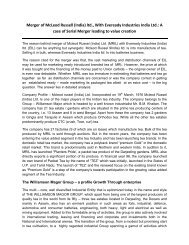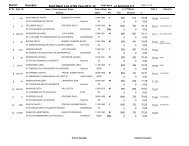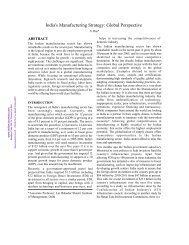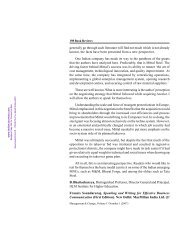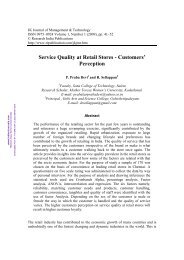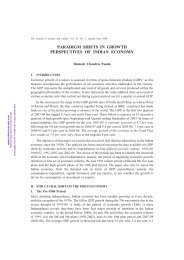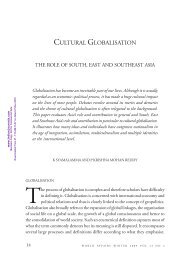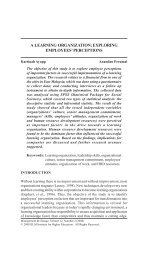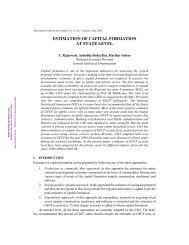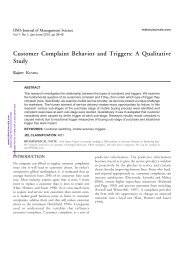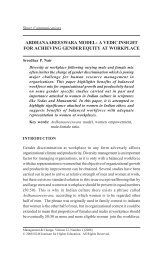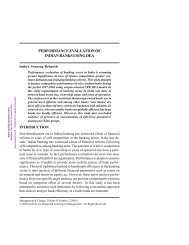compilation of national accounts statistics in india: a ... - Mimts.org
compilation of national accounts statistics in india: a ... - Mimts.org
compilation of national accounts statistics in india: a ... - Mimts.org
Create successful ePaper yourself
Turn your PDF publications into a flip-book with our unique Google optimized e-Paper software.
COMPILATION OF NATIONAL ACCOUNTS STATISTICS IN INDIA 105<br />
recommended the appropriate frame-work <strong>of</strong> regional <strong>accounts</strong>. The State DESs follow the<br />
recommendations <strong>of</strong> the Committee <strong>in</strong> their endeavor to improve the regional <strong>accounts</strong><br />
<strong>statistics</strong>.<br />
www.IndianJournals.com<br />
Members Copy, Not for Commercial Sale<br />
Downloaded From IP - 115.248.73.67 on dated 29-Nov-2010<br />
XV. Indian Participation <strong>in</strong> Inter<strong>national</strong> Comparison<br />
Inter-country comparison <strong>of</strong> level <strong>of</strong> economic growth is generally done <strong>in</strong> terms <strong>of</strong> per capita<br />
<strong>in</strong>come <strong>in</strong> US dollar us<strong>in</strong>g <strong>of</strong>ficial exchange rates. This, however, is not a satisfactory method<br />
as the exchange rate is not always a valid <strong>in</strong>dicator for measur<strong>in</strong>g the purchas<strong>in</strong>g power <strong>of</strong><br />
currencies. The UN Statistical Office, <strong>in</strong> collaboration with the University <strong>of</strong> Pennsylvania,<br />
USA undertook a project “Inter<strong>national</strong> Comparison Project (now Programme)-ICP” with the<br />
primary objective <strong>of</strong> evolv<strong>in</strong>g a suitable methodology for establish<strong>in</strong>g a system <strong>of</strong> comparisons<br />
<strong>of</strong> real product and Purchas<strong>in</strong>g Power Parities (PPP) <strong>of</strong> different countries.<br />
In Phase I <strong>of</strong> ICP six countries participated <strong>in</strong> 1967 and 10 countries <strong>in</strong> 1970. In Phase II<br />
<strong>of</strong> the project 10 countries participated <strong>in</strong> 1970 and 16 <strong>in</strong> 1973. In Phase I and II both b<strong>in</strong>ary<br />
and multilateral comparisons were carried out. In Phase III the comparison on similar l<strong>in</strong>es<br />
were made for the year 1975 <strong>in</strong> which 34 countries participated. The countries were classified<br />
<strong>in</strong>to regional groups and comparison was also made with a base country with<strong>in</strong> the region.<br />
India was chosen as base country for ESCAP comparison. From Phase IV, <strong>in</strong> which 60<br />
countries participated for the reference year 1980, regional comparisons were carried out. For<br />
Phase V where<strong>in</strong> 64 countries participated, core country concept was <strong>in</strong>troduced for l<strong>in</strong>k<strong>in</strong>g<br />
the results <strong>of</strong> regional comparisons to obta<strong>in</strong> the results <strong>of</strong> world comparison. India was one<br />
<strong>of</strong> the core countries <strong>in</strong> Phase V <strong>in</strong> the ESCAP region. The results <strong>of</strong> all the five phases have<br />
been published. Currently Phase VI <strong>of</strong> the ICP is on <strong>in</strong> which core commodity approach has<br />
been proposed <strong>in</strong> place <strong>of</strong> core country approach <strong>of</strong> Phase V, for l<strong>in</strong>k<strong>in</strong>g the regional results.<br />
This project is <strong>of</strong> particular <strong>in</strong>terest to the develop<strong>in</strong>g countries where<strong>in</strong> a large number <strong>of</strong><br />
transactions take place <strong>in</strong> non-monetary terms which are not always evaluated and taken<br />
account <strong>of</strong> <strong>in</strong> <strong>national</strong> <strong>in</strong>come estimation as contrasted to similar transactions <strong>in</strong> the developed<br />
countries. India did not participate <strong>in</strong> Phase VI. In VIIth Phase, 155 countries are participat<strong>in</strong>g.<br />
The Purchas<strong>in</strong>g Power Parity Prelim<strong>in</strong>ary Report <strong>of</strong> the 2005 Inter<strong>national</strong> Comparison<br />
Programme <strong>in</strong> Asia and the Pacific has just been (July 2007) brought out by the Asian<br />
Development Bank.<br />
XVI. Input-Output Transactions Tables<br />
An <strong>in</strong>put-output transactions table (IOTT) which describes the productive process <strong>of</strong> the<br />
complete economic system <strong>in</strong> a unified way, is an important analytical tool for analys<strong>in</strong>g the<br />
structure <strong>of</strong> production <strong>in</strong> the economy. IOTT is part <strong>of</strong> the <strong>in</strong>tegrated system <strong>of</strong> <strong>national</strong><br />
account<strong>in</strong>g. The Statistical Office, Department <strong>of</strong> Economics and Social Affairs, United<br />
Nations, has brought out a Technical Manual (Series F No.40, Rev.I) <strong>in</strong>dicat<strong>in</strong>g details about<br />
construction <strong>of</strong> IOTT and the various problems <strong>of</strong> <strong>in</strong>put-output analysis.<br />
The construction <strong>of</strong> IOTT was <strong>in</strong>itiated <strong>in</strong> India <strong>in</strong> the early fifties. The first <strong>in</strong>ter-<strong>in</strong>dustry<br />
table for India was prepared by M. Mukherjee for 1949-50 <strong>in</strong> 1953 which was subsequently<br />
published <strong>in</strong> Sankhya <strong>in</strong> 1954. This table had only 4 sectors and was arrived at by allocat<strong>in</strong>g by<br />
<strong>in</strong>dustries the costs <strong>of</strong> various <strong>in</strong>dustrial sectors us<strong>in</strong>g <strong>in</strong>formation conta<strong>in</strong>ed <strong>in</strong> the “First



